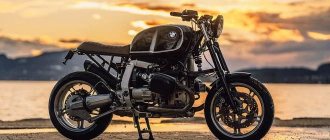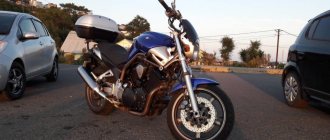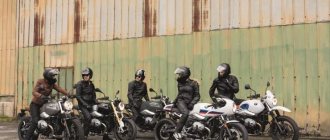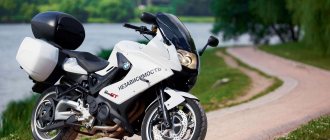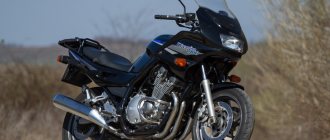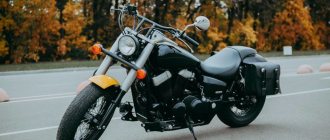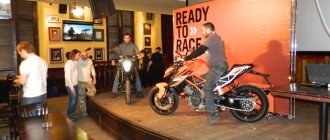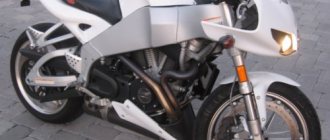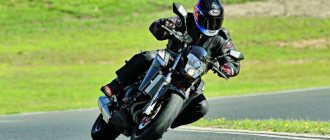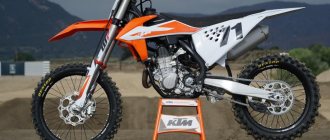Model class : road.
Years of production/sales: 2000-2006
The BMW R1150R was first introduced in 2000 as a replacement for the BMW R1100R. In addition to visual changes (wheels, shape of the front fender, seat and gas tank), the model receives a number of technical improvements. Firstly, there is a new 1130 cc engine. cm, producing more power and torque (85 hp, 98 Nm). Secondly, the integral (combined) ABS system (or 2nd generation ABS), which works more efficiently, but is technically more complex and less reliable compared to ABS on the BMW R1100R. Thirdly, a more powerful braking system (the diameter of the front brake discs has been increased from 305 mm to 320 mm). Fourthly, the size of the wheels (120/70 ZR 17 - front, 170/60-ZR 17 - rear), which were taken from the sports version of the BMW R1100S. Fifthly, a 6-speed gearbox, instead of the traditional 5-speed gearbox for the 1100 series (except for the R1100S), and a hydraulic clutch drive, which solves the problem of cable breakage on 1100 series models.
Main modifications of the BMW R1150R:
- BMW R1150R – regular version.
- BMW R1150R Rockster – produced from 2003 to the end of 2005. It differs in appearance (frame, valve covers and fork are blue, except for 2005 models; electronic clock, white tachometer, striped coloring of the motorcycle, double headlight from R1150GS) and in technical parts (automatically switched off turn signals, two spark plugs per cylinder, 87 hp power, closely spaced gearbox ratios, rear tire size - 180/55 ZR 17).
Otherwise, the BMW R1150R model has a classic layout common to all flagship BMW motorcycles - a 2-cylinder air-oil-cooled fuel-injected boxer engine, a frame with the engine as a load-bearing structural element, proprietary Telelever and Paralever suspensions, powerful Brembo disc brakes with ABS as an option , standard heated grips and traditional cardan drive to the rear wheel.
The BMW R1150R model was produced until the end of 2005, and since 2006 it gave way to the updated version of the BMW R1200R.
The “younger brother” of the BMW R1150R model is the BMW R850R (2003-2005).
Specifications
Technical characteristics of BMW R1150R:
| Model | BMW R1150R |
| Motorcycle type | road |
| Year of issue | 2000-2006 |
| Frame | composite, aluminum front part, engine - load-bearing element |
| engine's type | 2-cylinder 4-stroke boxer (Boxer) |
| Working volume | 1130 cc |
| Bore x Stroke | 101x70.5 mm |
| Compression ratio | 10.3:1 |
| Cooling | air-oil |
| Number of valves | 4 valves per cylinder, 1 camshaft per cylinder head |
| Fuel supply system | Bosch Motronic MA 2.4 injector |
| Ignition type | electronic |
| Maximum power | 85 hp at 6750 rpm (87 hp - Rockster version) |
| Maximum torque | 98 Nm at 5250 rpm |
| Transmission | 6-speed |
| type of drive | cardan |
| Front tire size | 120/70 ZR 17 |
| Rear tire size | 170/60-ZR 17 (180/55 ZR 17 - Rockster version) |
| Front brakes | 2 discs, 320 mm, 4-piston calipers (optional ABS 2nd generation) |
| Rear brakes | 1 disc, 276 mm, 2-piston caliper (optional ABS 2nd generation) |
| Front suspension | BMW Telelever (preload adjustment), stroke - 120 mm |
| Rear suspension | pendulum BMW Paralever (preload and rebound adjustment), stroke - 135 mm |
| Overall dimensions (LxWxH) | 2170 x 970 (with mirrors) x 1220 mm |
| Seat height | 800 mm |
| Gas tank capacity | 20.4 l |
| Maximum speed | 197 km/h |
| Acceleration to 100 km/h (0-100) | 4.23 sec |
| Motorcycle weight (curb) | 238 kg |
Test drive BMWR 1150 R Rockster
When I first sat on the BMW R1150R Rockster, I clearly imagined its habitat - smooth European roads, intricately winding through a pastoral landscape, a cool but sunny day and the obligatory mountains on the horizon.
No matter how many names they call this model: here you have a streetfighter, a naked, and a sports tourer, but everything is past, but this Bavarian is a roadster from the “brains” to the crankshaft bearings.
It was a good day for the test drive - sunny, dry, but not hot. Having escaped the city crowd outside the city, the BMW owner and I exchanged motorcycles. Before riding the “unknown animal”, I had to make a roundabout walk - useful, you know...
The basis of this motorcycle is an injection two-cylinder boxer with a volume of 1130 cm3, a “boxer”, as they say abroad. In general, I have always been interested in the efficiency of heat removal from engines of this series, because the cooling here is air-oil, the fins are modest, and 85 hp. – this is a lot. What if you get stuck in traffic on a hot summer day? After all, with such ground clearance there is nothing to do on the curbs, and because of the splayed cylinders, you can’t really squeeze between the cars. “Come on, Herr Serge, look, you’re not testing a scooter,” my conscience reproached me with a German accent, “you should have driven it into the forest to get the full experience!” Having hidden it (conscience) deeper, I continued to study the “patient”.
There is no frame as such here - its functions are performed by the engine itself and two satellite subframes. The suspension is traditional: telelever at the front and paralever at the rear, and the shock absorbers have adjustable spring preload and rebound damping. Of course, there are still some tweaks to be made, but I can't imagine an R1150R owner tweaking the settings every day, trying to beat his own lap record on the 'ring.
The controls are standard... for BMW. Unlike the K1200RS, which was test driven two months earlier, only the cruise control toggle switch on the left console is missing. Everything else is one to one. The dashboard does not have a modern design, but it is very readable. If we take into account the Bavarian origin of the motorcycle and the Germans’ desire to embed a computer even in a ballpoint pen, then the set of information provided can be called rather poor. For example, there was nothing stopping you from installing a full-fledged fuel gauge here, and an engine temperature indicator would not be at all superfluous (not to mention the gear indicator and other interesting, but not particularly necessary, “gadgets”).
The traditional round is completed, I sit in the saddle, turn the key in the ignition and press the starter button, located in the “proprietary” (well, everything is not like people!) place. The dry sound of the starter grew into a rich hum that burst out of the tuning Akrapovic. The sound is not loud, but pleasant.
Having accelerated in place, I really felt that the boxer engine was persistently trying to turn the motorcycle around itself - a peculiar sensation, I must say. Having squeezed the lever of the moderately tight hydraulic clutch and put it in first gear, I drove out onto the highway. But the landing is okay: comfortable, with a slight tilt forward... The steering wheel, however, is also tuning - the original one is lower and moved further back. Thanks to the low seat height of 770 mm, even short riders will be comfortable on this “Bavarian”.
The peculiarity of the engine layout appeared during the first active acceleration. At the moment of switching, the motorcycle first swung sharply to the left, and then to the right - perhaps it’s not for nothing that it’s called a “rockster.” Because of this effect, it is very difficult (and actually damn scary) to drive dynamically if you are not used to it. To reduce the jerk, you must either shift “up” without a clutch, fortunately, the gearbox welcomes this, or work very smoothly with the gas, but then goodbye dynamics.
The sample we tested had a completely unnecessary tuning windshield, since there is no standard wind protection here (well, why not call that blotch that doesn’t even protrude above the dashboard “windshield”?). Thanks to this, the comfortable speed on the highway was 150-160 km/h, and even at “200” there was no obvious discomfort.
The stability dictated by the 238 kilograms of curb weight creates the feeling of flying astride a cast iron iron, which, in addition, is filled with coal in the amount necessary for a trip across the Atlantic. Neither side winds nor oncoming cars deviate the motorcycle from a given trajectory, but the engine continually tries to spin the motorcycle around itself. However, with increasing speed, this effect becomes dulled due to the fact that the wheels themselves become gyroscopes and resist any change in the plane of rotation.
It was here, on the track, that the engine's potential was revealed. Perhaps this is one of the most flexible power units, second only to the “in-line” one on the K1200RS. In the highest, sixth gear, you can drive 40 km/h, and from 50 you can confidently accelerate, without jerks in the transmission. The engine begins to pull already from 2 thousand revolutions, but at four to five thousand, when the phlegmatic hum begins to turn into the roar of a bull that has pinched its most important organ, small high-frequency vibrations arise. They “blur” the image in the mirrors and noticeably tickle your feet even through the rubber pads and soles of the motorcycle boots. With further increase in speed they do not disappear, but become less unpleasant.
Once out on the highway, you can forget about the stiff but clearly functioning gearbox - the excellent traction characteristics of the engine eliminate the need to constantly “oil” the gearbox foot. Yes, it does not amaze with cosmic dynamics, but 85 hp. and 100 Nm will be a good help on long overtaking, and the adequate nature of their increase will reduce the likelihood of excesses on slippery surfaces.
On a deserted section of the highway, it became possible to check the dynamics of deceleration, without fear that a Georgian driver, walking in the wake of a “penny”, would park “in the back” and ask a philosophical question: “Daragoy, why are you braking so fast, right?” The brake system of the R1150R, traditionally for BMW, is equipped with an electronic booster and ABS, and thanks to reinforced hoses, when you press the lever there is no feeling that you are pressing a button. To put it in the usual language: there is good feedback, which was absent, as a concept, on the recent K1200RS. Performance is fantastic. But this only applies to the front brake. The rear one is moderately indistinct.
Having accelerated and slowed down, I felt a certain “wrongness”, or rather, the unreality of what was happening - something unchangeable, good, eternal was missing. After repeating the procedure, it dawned on me that there was no dive when braking. At all. Actually, this is what the Germans achieved with their “teleever”.
Soon the first city traffic lights loomed ahead and from the “cruising” 140-160 I had to drop to the “traffic” 40-60 km/h. At low speeds, the Bavarian tends to straighten its trajectories. Strange thing: the often mentioned K 1200 RS suffered from oversteer, but this one exhibits understeer. It is worth noting that it is easy to get used to this - after two hours I no longer understood what had previously annoyed me so much.
Unfortunately (or fortunately?), it was not possible to find a decent traffic jam, about three hundred to five hundred meters long, and at a standard city pace the huge boxer didn’t even think about overheating (maybe it just didn’t show it?). However, he showed himself in other ways. Thanks to its considerable width, which was increased by the protective arches, it was difficult to squeeze between the cars. But if you press to the side of the road and pass the right cylinder over the curb, then the “geometric passability” of congestion increases by one and a half times.
In such conditions I appreciated the mirrors. I would characterize the visibility in them as necessary and sufficient, but the best thing is that they almost do not extend beyond the width of the steering wheel, and therefore do not tend to cling to other vehicles.
The suspensions, tuned for a comfortable ride, did not give in to bad asphalt and stoically endured speed bumps and tram rails, providing the motorcycle with a smooth ride. But in significant slopes, the handling of unevenness was far from ideal - after all, the telelever lever and massive pipes significantly increase the unsprung masses. But this device is not for the track, so what can we find fault with... Driving on average quality asphalt at 120-130 km/h is quite comfortable - the suspension manages to absorb most of the defects in the road surface, and what was missed is effectively dampened by the soft seat.
The head light of this model is as unique as everything else: the low beam, for which the lens headlight is responsible, is frankly weak, but is compensated by the powerful high beam (although you can’t tell by the size of the headlight reflector).
The unusual “look” of the optics fully reflects the character of the motorcycle: a little eccentric, crazy and spontaneous, but with a spice, in which (somewhere deep) one can discern the innate German stiffness and pedantry - that’s exactly what it is, the BMW R 1150 R.
Text: Sergey Kuznetsov
Photo: Vladimir Kuznetsov
Motorcycle BMW R 1150R 2003 review
The description of the BMW R 1150R 2003 motorcycle is in the queue for publication of the article. Announcement: Today, for almost every new motorcycle that comes into being, marketers strive to carve out their own niche. This one is a road sport, this one is a recreational enduro. But what class should we include a motorcycle that has a little bit of everything? A good bike should have a reliable engine, comfortable ergonomics and simple controls...
The BMW R 1150R is a motorcycle of average popularity in Russia, equipped with a high-power 85 hp engine. Despite the fact that good models of motorcycles have a very respectable price, and the season for their use is relatively short, the motorcycle market is developing rapidly. And if you believe the words of dealers, then some models of recently released motorcycles are selling like hot cakes at the beginning of the season, and the models brought to Russia are clearly not enough to fully satisfy consumer demand.
A motorcycle has long ceased to be an alternative to a car, and the times when this equipment was bought only because there was not enough money for a full-fledged car are forgotten. Nowadays, two-wheelers can be called technological marvels in many cases, and their cost can be compared with that of prestigious cars.
Many people have started buying motorcycles for hobby purposes as riding or even collecting them has become a good pastime for many people. Many motorcycles, for example the BMW R 1150R, whose technical characteristics make it possible to call the model a prestigious brand, are in demand among both beginners and experienced motorcyclists.
Currently, it is impossible to purchase a new BMW R 1150R motorcycle from the 2003 model year, since their production stopped 13 years ago. At the same time, the BMW R 1150R has excellent technical characteristics, so many people strive to purchase, if not a new, then at least a used version.
Motorcycles with an engine capacity of 1130 cc. see, appeared as a result of long work of inventors who sought to create a model that was not inferior in characteristics to other versions of the motorcycle. In some cases, these models are not only not inferior, but also ahead of other motorcycles, as they have minimal fuel consumption and other excellent parameters.
Motorcycles with an engine capacity of more than 400 kb. cm, which includes the BMW R 1150R - this category of motorcycles simply cannot claim the title of “motorcycle for a beginner.” On the contrary, this is already a serious technique that requires certain control of motorcycle equipment with a smaller engine capacity. Yes, she attracts more attention, she is the most beautiful, fast, interesting and there is a huge selection of models. But as power increases, the weight of the motorcycle inevitably increases. In this class you are unlikely to find motorcycles lighter than 180 kg, unless they are the latest motorcycle models.
Go to the entire range of BMW motorcycles, on this page you can find BMW R 1150R motorcycles from other years of production and information about them
Briefly about Rke, how I bought it, what I did. Just for history, and for those who are tormented by the choice and do not know whether this pepelats is suitable for them. In the summer of 2014, I was finally ready to buy a motorcycle with documents and receive a category. Since my wife is strongly against motorcycles, after this decision, several more months were spent secretly preparing for the purchase. In particular, the choice of motorcycle model. At that time, I had only short trips on friends’ motorcycles, and they were all some kind of naked/street bikes - stels trigger 50, yamaha srx 400, honda vtr1000 (converted to street after an accident). Therefore, I imagined my money in approximately the same way.
I don’t remember at all how it happened that I fell for the r1150r. But I remember exactly what the fuse was. I liked everything about it - the opposed boxer sticking out, the cantilever wheel suspension, the old-fashioned tidy with two tachometer/speedometer wells and a small clock on top, the tank with nostrils (which contain radiators), even the front beak, which infuriates many, seemed to me (and seems to be still) quite harmonious. I tried to look for reviews, but there are really a couple of them on the entire Internet. I was most worried about the weight and height - I was afraid that without experience it would be extremely difficult, because... I'm only 170cm. As everyone here understands, this is nonsense and childish fears.
How long, short, and somewhere around December I chose a motorbike from Japan on the way from the author and began to wait. Before this, I told my missus that “I decided to graduate from category A and buy a motorcycle.” To which I heard “Yes, yes, of course.” I didn't believe it, that is. Well, I told you that bribes are fine with me))) I chose the color blue with a beige seat. I really liked her from the photos. Good live too.
What can a neophyte say about a motorcycle? If you like the look, feel free to take it. The bike accelerates great, brakes great, and turns well. He does all this in the city, on the highway, and on the dirt road. With the arrival of the season, I go every day to work, to the dacha, or just to ride around the city and in the region. The only thing I personally lack is the clearance to drive along forest paths with all sorts of logs across and half-wheel ruts.
Next, a little more detail on the points
Appearance Apparently not for everyone. Since I am one of the amateurs, I don’t understand how anyone can not like it))) An open engine with a bunch of all sorts of ribs, edges, pieces of hardware, interfaces and all this machinery. The color red is absolutely beautiful, now I like it even more than my blue-beige.
Landing My Nippon vehicle had steering wheel spacers, and I still sit with a slight forward tilt. I feel quite comfortable, nothing stiffens, my back doesn’t hurt (and my back, like many people’s, is capricious). With my weight and dimensions (170 cm height, 85 kg weight), the motorcycle was immediately absolutely comfortable in all situations. And now my legs have grown and I’m not even tall enough anymore, I want more. At the same time, my brother from Smolensk (188 cm and about a third wider than me at the shoulders) looked purely like a German invader and did not give the impression of a bear on a bicycle. Yes, it would probably be generally a little low in everyday driving, but not fatal.
Suspension Well what can I say. Chic pendant on telelever/paralever. Doesn't bite, works out holes. The Rke has rebound adjustment both front and rear. At the rear, the preload is still tightened manually. From the moment of purchase until this fall, I never played either one or the other. And then I decided to send the shock absorbers to be rebuilt, and in communication with Yura I found out how it should work. I can’t say whether it worked before, but after the rebuild, the stiffness of the suspension actually changes and overall the motorcycle began to behave better. The swaying on the waves and the breakdowns in the front disappeared when I drove 100 km/h along the grader to the dacha. Those. I’ve ridden like this before, but during these 8 km there were always 1-2 places where the front broke through, and it was annoying. And now there’s no such thing and it’s a thrill.
Engine A little over a liter, 85 horses, 95 newtons per meter, injector. Personally, I (personally) had enough everywhere and always. No overtaking caused any problems - there was clearance, I unscrewed the handle, accelerated from 120 to 160 in a couple of seconds, overtaking was completed. The way it should be on a motorcycle. But not this muchilov on a 1.5 liter carb intruder - oh, you’ve already overtaken, I won’t have time here, I’ll wait for god’s sake until the passing cars won’t overtake. And so 5700 km to Kazakhstan and back. Eats something like 6-odd liters. I get about the same results both in the city and on the highway. Apparently because I'm piling on.
Brakes Combined with electric booster and ABS. They brake great while they work (more on that later).
Wind protection Many people believe that if there is no wind protection, then the motorcycle is not designed for long-distance riding. I personally travel from St. Petersburg to Smolensk every year. This is 850 km one way - I don’t experience any problems. The driving mode is usually 140-160 mph, depending on the quality of the road surface and traffic density, with accelerations up to 180 when overtaking. So, up to 140 km/h I don’t feel any wind at all, so you can drive all day. You can drive 160 all day too, but you will get tired. I personally withstood 180 for 3 hours in a row, but on the previous day I also pushed it pretty hard, and I felt tired right away. It’s clear that if there were good wind protection, you could push 180 all day long without fatigue. But there you already get very tired from the speed. I see the main disadvantage is that from under the pots my feet get covered in water/dirt up to my knees. Any wet road results in wet pants up to the knee. The geese have the same problem, there are even some deflectors, but I was too lazy to install them. I brought a large windshield for my trip to Kazakhstan. I don’t remember that it was somehow radically better. But I remember how once I was going to put it on a trip to Smolensk. I parked it in the garage and drove 25 km through the city to the house, almost freaked out by the noise. It felt like the whole wind was blowing into my head, and with swirls at that. I tried to adjust the angle of the glass to get rid of it, but I couldn’t. I don’t understand how it happened that I went to Kazakhstan normally with him. Maybe the luggage in the back changed the aerodynamic silhouette, I don’t know.
Reliability\Sores When I bought it, I knew about the two main sores of the old 1150 - failing ABS and splines on the clutch/input shaft of the box, which are eaten up at high mileage. Oh, no, three problems - also the wiring of the Hall sensor, which crumbles and shorts out. But the third one can be solved by yourself without any problems, so I didn’t worry about it. For the second and first ones, too, not much - because I took a motorbike with a mileage of 37tkm. Yes, I was young and somehow had no doubt about the mileage - obviously my grandmother went to buy bread. I can say that the condition corresponded to such a mileage, my naivety did not let me down))
In the first season, the clutch slave cylinder died. This is also a well-known problem, but for some reason it’s not as popular for discussion as the others, so I missed it. The bottom line is that there is a thrust bearing in the slave cylinder, and it is through it that the piston presses on the rod, which already presses on the basket to release the clutch. And if the lubricant dries out in the bearing, the piston begins to rotate, this kills the seal and the brake fluid begins to get on the clutch and the gearbox seals. Accordingly, the clutch will begin to slip and the seals will collapse. After some time, these seals will break and oil will begin to flow onto both the long-suffering clutch and the resonator. Well, the clutch will be lost, just like without it. That's all I caught. True, the clutch does not die instantly; it will first start working with two releases, as in the old ZIL. If at this moment you look into the reservoir on the clutch handle, you will see some gray liquid instead of a transparent brake fluid. I recommend immediately starting to look for the clutch cylinder. I didn’t understand what this meant and drove for another week until the clutch completely failed. You can avoid this fate if you change the lubricant in this bearing and change the brakes in the clutch every two seasons. Dead bearing Dead clutch cylinder Clutch in brake fluid and oil As a bonus - dead clutch rod
I changed the clutch slave cylinder without disassembling the engine, I just lifted the ass a little, crawled up and changed it. Well, because a) I didn’t know that the seals would also suffer, b) it’s the season, I want to ride. I replaced it in one evening with one person and drove two months until the end of the season. Towards the end of the season, oil began to get onto the resonator, smoking and stinking. But I got there like that. I learned about the seals already in the off-season. Then the spendthrift already halved and changed everything.
That same winter, I re-soldered the Hall sensor wiring, and in the spring I installed reinforced hoses on the brakes. I also changed the fuel pump in the tank, just as a preventative measure. I think I've overdone it. Last season I shook the rear wheel and discovered a small play. I adjusted the preload on the pendulum bearings - the play went away. Then I adjusted the valves and synchronized the injectors. Well, every year oil, filters, pumping ABS - this is just ordinary maintenance.
In general, maintenance is quite simple, everything has a detailed manual in electrical form and a bunch of videos where everything is chewed. If there was a desire, it could be serviced and some of the repairs could be done simply in the parking lot. And if you have a garage, then no problems at all. So I consider the stories about the breaking of the bnv to be ordinary, incomprehensible hatred for me. But if you don’t want to do anything yourself, then yes, you’ll have to pay someone. But are there 18-20 year old motorcycles that do not require periodic repairs? I doubt it.
